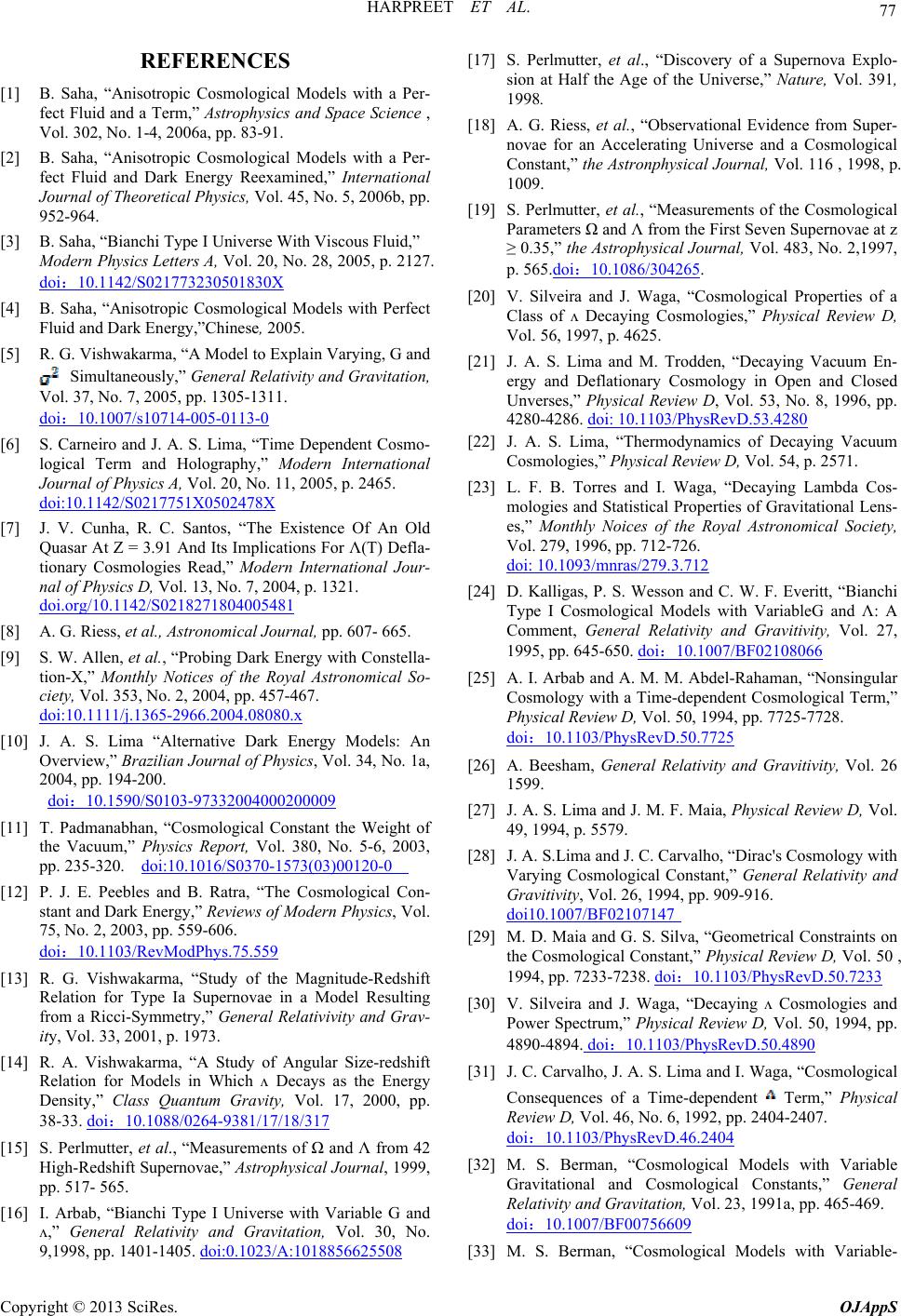
HARPREET ET AL. 77
REFERENCES
[1] B. Saha, “Anisotropic Cosmological Models with a Per-
fect Fluid and a Term,” Astrophysics and Space Science ,
Vol. 302, No. 1-4, 2006a, pp. 83-91.
[2] B. Saha, “Anisotropic Cosmological Models with a Per-
fect Fluid and Dark Energy Reexamined,” International
Journal of Theoretical Physics, Vol. 45, No. 5, 2006b, pp.
952-964.
[3] B. Saha, “Bianchi Type I Universe With Viscous Fluid,”
Modern Physics Letters A, Vol. 20, No. 28, 2005, p. 2127.
doi:10.1142/S021773230501830X
[4] B. Saha, “Anisotropic Cosmological Models with Perfect
Fluid and Dark Energy,”Chinese, 2005.
[5] R. G. Vishwakarma, “A Model to Explain Varying, G and
Simultaneously,” General Relativity and Gravitation,
Vol. 37, No. 7, 2005, pp. 1305-1311.
doi:10.1007/s10714-005-0113-0
[6] S. Carneiro and J. A. S. Lima, “Time Dependent Cosmo-
logical Term and Holography,” Modern International
Journal of Physics A, Vol. 20, No. 11, 2005, p. 2465.
doi:10.1142/S0217751X0502478X
[7] J. V. Cunha, R. C. Santos, “The Existence Of An Old
Quasar At Z = 3.91 And Its Implications For Λ(T) Defla-
tionary Cosmologies Read,” Modern International Jour-
nal of Physics D, Vol. 13, No. 7, 2004, p. 1321.
doi.org/10.1142/S0218271804005481
[8] A. G. Riess, et al., Astro nomical Journal, pp. 607- 665.
[9] S. W. Allen, et al., “Probing Dark Energy with Constella-
tion-X,” Monthly Notices of the Royal Astronomical So-
ciety, Vol. 353, No. 2, 2004, pp. 457-467.
doi:10.1111/j.1365-2966.2004.08080.x
[10] J. A. S. Lima “Alternative Dark Energy Models: An
Overview,” Brazilian Journal of Physics, Vol. 34, No. 1a,
2004, pp. 194-200.
doi:10.1590/S0103-97332004000200009
[11] T. Padmanabhan, “Cosmological Constant the Weight of
the Vacuum,” Physics Report, Vol. 380, No. 5-6, 2003,
pp. 235-320. doi:10.1016/S0370-1573(03)00120-0
[12] P. J. E. Peebles and B. Ratra, “The Cosmological Con-
stant and Dark Energy,” Reviews of Modern Physics, Vol.
75, No. 2, 2003, pp. 559-606.
doi:10.1103/RevModPhys.75.559
[13] R. G. Vishwakarma, “Study of the Magnitude-Redshift
Relation for Type Ia Supernovae in a Model Resulting
from a Ricci-Symmetry,” General Relativivity and Grav-
ity, Vol. 33, 2001, p. 1973.
[14] R. A. Vishwakarma, “A Study of Angular Size-redshift
Relation for Models in Which ᴧ Decays as the Energy
Density,” Class Quantum Gravity, Vol. 17, 2000, pp.
38-33. doi:10.1088/0264-9381/17/18/317
[15] S. Perlmutter, et al., “Measurements of Ω and Λ from 42
High-Redshift Supernovae,” Astrophysical Journal, 1999,
pp. 517- 565.
[16] I. Arbab, “Bianchi Type I Universe with Variable G and
ᴧ,” General Relativity and Gravitation, Vol. 30, No.
9,1998, pp. 1401-1405. doi:0.1023/A:1018856625508
[17] S. Perlmutter, et al., “Discovery of a Supernova Explo-
sion at Half the Age of the Universe,” Nature, Vol. 391,
1998.
[18] A. G. Riess, et al., “Observational Evidence from Super-
novae for an Accelerating Universe and a Cosmological
Constant,” the Astronphysical Journal, Vol. 116 , 1998, p.
1009.
[19] S. Perlmutter, et al., “Measurements of the Cosmological
Parameters Ω and Λ from the First Seven Supernovae at z
≥ 0.35,” the Astrophysical Journal, Vol. 483, No. 2,1997,
p. 565.doi:10.1086/304265.
[20] V. Silveira and J. Waga, “Cosmological Properties of a
Class of ᴧ Decaying Cosmologies,” Physical Review D,
Vol. 56, 1997, p. 4625.
[21] J. A. S. Lima and M. Trodden, “Decaying Vacuum En-
ergy and Deflationary Cosmology in Open and Closed
Unverses,” Physical Review D, Vol. 53, No. 8, 1996, pp.
4280-4286. doi: 10.1103/PhysRevD.53.4280
[22] J. A. S. Lima, “Thermodynamics of Decaying Vacuum
Cosmologies,” Physical Review D, Vol. 54, p. 2571.
[23] L. F. B. Torres and I. Waga, “Decaying Lambda Cos-
mologies and Statistical Properties of Gravitational Lens-
es,” Monthly Noices of the Royal Astronomical Society,
Vol. 279, 1996, pp. 712-726.
doi: 10.1093/mnras/279.3.712
[24] D. Kalligas, P. S. Wesson and C. W. F. Everitt, “Bianchi
Type I Cosmological Models with VariableG and Λ: A
Comment, General Relativity and Gravitivity, Vol. 27,
1995, pp. 645-650. doi:10.1007/BF02108066
[25] A. I. Arbab and A. M. M. Abdel-Rahaman, “Nonsingular
Cosmology with a Time-dependent Cosmological Term,”
Physical Review D, Vol. 50, 1994, pp. 7725-7728.
doi:10.1103/PhysRevD.50.7725
[26] A. Beesham, General Relativity and Gravitivity, Vol. 26
1599.
[27] J. A. S. Lima and J. M. F. Maia, Physical Review D, Vol.
49, 1994, p. 5579.
[28] J. A. S.Lima and J. C. Carvalho, “Dirac's Cosmology with
Varying Cosmological Constant,” General Relativity and
Gravitivity, Vol. 26, 1994, pp. 909-916.
doi10.1007/BF02107147
[29] M. D. Maia and G. S. Silva, “Geometrical Constraints on
the Cosmological Constant,” Physical Review D, Vol. 50 ,
1994, pp. 7233-7238. doi:10.1103/PhysRevD.50.7233
[30] V. Silveira and J. Waga, “Decaying ᴧ Cosmologies and
Power Spectrum,” Physical Review D, Vol. 50, 1994, pp.
4890-4894. doi:10.1103/PhysRevD.50.4890
[31] J. C. Carvalho, J. A. S. Lima and I. Waga, “Cosmological
Consequences of a Time-dependent Term,” Physical
Review D, Vol. 46, No. 6, 1992, pp. 2404-2407.
doi:10.1103/PhysRevD.46.2404
[32] M. S. Berman, “Cosmological Models with Variable
Gravitational and Cosmological Constants,” General
Relativity and Gravitation, Vol. 23, 1991a, pp. 465-469.
doi:10.1007/BF00756609
[33] M. S. Berman, “Cosmological Models with Variable-
Copyright © 2013 SciRes. OJAppS